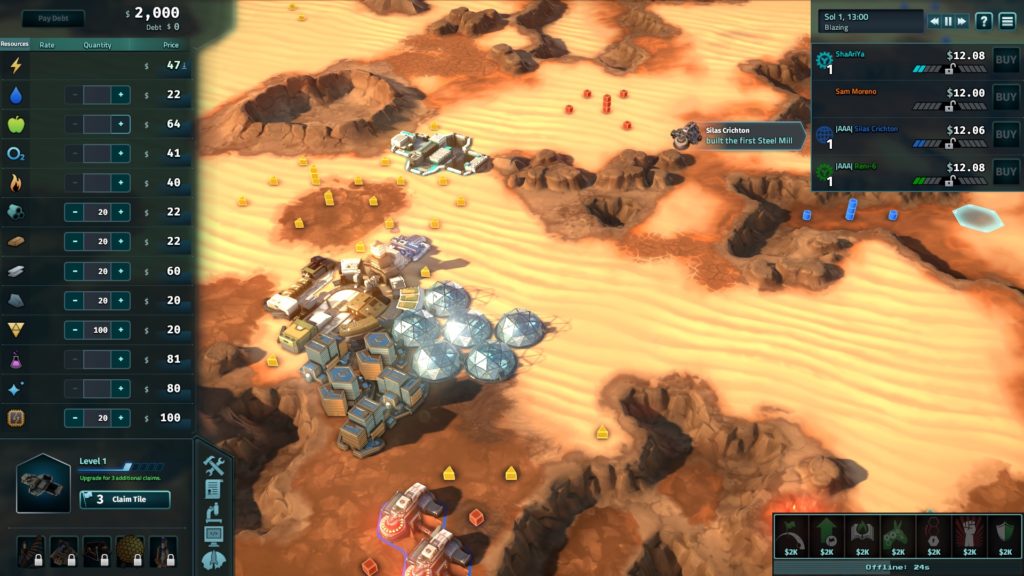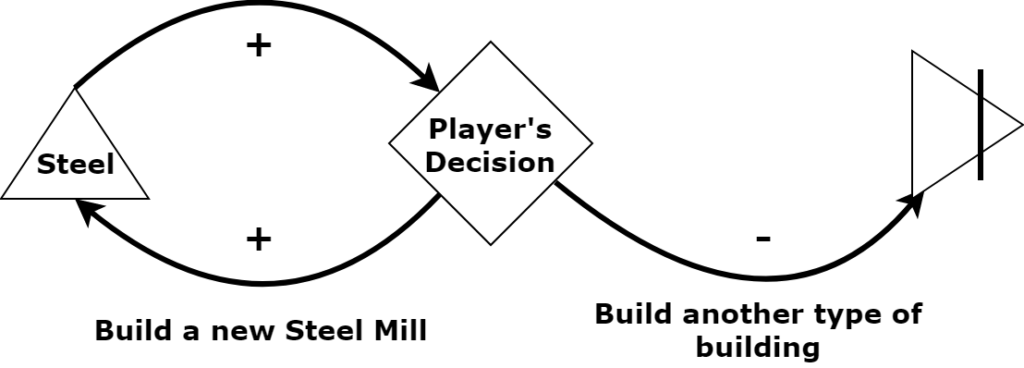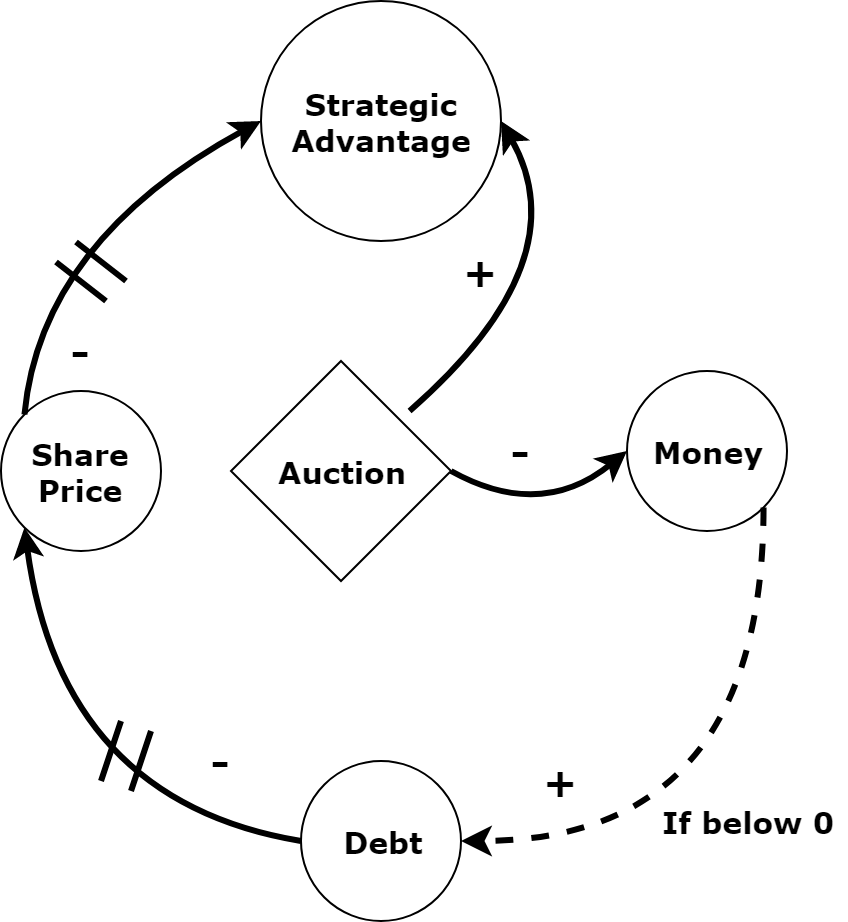One of my first games created in the RTS genre was Our Planet is Dying, a spaceship-themed game with grid movement in the Space (combat units) and free movement on the Base (resource-gatherer units). The overall gameplay was judged positively by the testers, but something was missing. Some time after the playtest session I realized that the main problem was the Base, specifically how resources were managed by players and the unexisting amount of disruption that it could suffer on the resource flow. It was basically a safe space with nothing interesting to do more than constantly gather resources to build more units. No trade-offs, no threats and no deep management needed. I turned my head to Offworld Trading Company, a game that is all about managing resources, to analyze how they did it in order to apply this knowledge to future games and create better experiences for players.
To make a summary of Offworld Trading Company, is an RTS game but unlike many others, it doesn’t has guns, direct combat or anything like that. It’s essentially an economic RTS where players fights against each other buying stocks of other players until they are out of the game. One of the particularities of this game is that it has 13 resources! At first glance (and at second too, maybe) they seem like a lot of resources, but it’s mitigated with an effective tutorial, a well directed gameplay and also taking into account that resources and building are effectively the player’s units (in the traditional RTS sense), so an average RTS player will have no trouble understanding and using those resources.

You can see all the resources at the left of the screen. On the top of the panel are the raw resources while at the bottom are the manufactured resources
Three types of Gameplay Loops in Offworld Trading Company
The first stop will be the gameplay loops. This is a topic that is analyzed in deep in the book “Advanced Game Design: A systems approach”, so I will explain the types of gameplay loops that are most relevant to this analysis, but if you want to know more about them I can’t recommend enough the aforementioned book.
In the game we can identify a type of engine called Boosting Engine. These type of loop creates a resource and give the player two choices inside the loop, one be using the resources to increase the flow of resources from the source or to use the resources acting on the game. For example, the construction resources in Offworld Trading Company make up a boosting engine, because the player can use those resources to act in the game (i.e create new buildings) or to create buildings that are sources of those construction resources, increasing the amount of construction resources available to the player. We have to remember that Offworld have 13 resources, but each HQ type use 3 resources to build new buildings. Also, the player can buy other players’ shares, that periodically provide money for the player, conforming another type of boosting engine.

Engine Loop: The player have the option to build more steel mills to increase the amount of steel, or use it to create another building, effectively mixing an Engine with an Economy loop
Economy Loops consist mainly of a reinforcing loop, where the player choose between trade a resource for another or to invest on upgrades to enhance or combine resources, creating a more valuable resource. Obviously, Offworld as an economic simulation RTS game, consist mostly of economic loops. The main tool for the player to act in the game is money, which is obtained by selling resources and buying other players’ shares. If is lacking construction resources to buy a new building, the player can use money in order to “buy” those resources (a process that happen automatically in order to reduce the cognitive weight on player’s mind). Another type of economy is the use of raw resources to create manufactured resources, that are usually more valuable than raw resources and therefore, the player can make more money selling those type of resources. But where Offworld really excels is in the economic interaction between players. Some resources can suffer surplus or shortages from time to time, decreasing or increasing the resource value respectively. Players have buildings like the Hacker Array to create artificial surplus or shortages, creating a disruption in the use of the resources on the other players. A player can also create a resource that another player needs, for example if a Robotic HQ is founded, a player selling electronics early in the game can make a good amount of money when the Robotic HQ is lacking electronics.

Economy Loop: It all starts with a water pump. The water could be sold for money or converted into Fuel, that have a higher price but it could also be converted into Chemicals, that have even a higher price. Economies usually consist of nested loop inside an outer loop
Ecology Loops are mainly a balancing loop, that tends to a certain balance point. Balancing loops can create the type of effect called “rubberbanding”, used to reduce the gap between the player in a winning position and players on losing positions. One type of ecology in this game is debt. If player can’t produce a resource that they need, the system automatically buy those resources for them, at the cost of debt. Also, players can acquire debt buying on random auctions that happen every new day. A player can massive advantage in the short-term buying an specific building on these auctions, but if the player acquire debt, their share price will decrease, making easier for other players to buy their shares and get them out of the game. Ecologies tend to create metastable loops inside a certain working range. When the game is near the end, the loop begins to work more aggressively outside this range, creating what is called a “brittle ecology”. For example. if a player have just recently take out another player buying their company, it will gain a massive advantage that will make the game end fast, unless another player buy another player company, making the ecology of the game work inside the stable range again. This is a very good Game Design decision, to avoid a game with a player that is massively ahead but can’t win because the game is constantly “rubberbanding” players (a crime that is usually exemplified with “Monopoly” and the endless sessions of play where the winner is usually decided on the first 10 minutes).

Ecology Loop: An auction can give the player a short-term strategic advantage, in the long-term though, especially if the player is running low on cash, the Share Price will drop and it will decrease the strategic advantage
Last but not least, is the Black Market. These are a series of mechanics that the player can use to disrupt the flow of resources of enemy players, like disable buildings or stealing a part of the resources (in between the path from the source of resources to the HQ). There are other options to buy in the Black Market, like a MULE to extract raw resources without an extract building, protect a building or buy a new claim. One interesting mechanic is that each time a player buy a Black Market tool, that tool price rises, creating an ecology loop where the value to buy a certain tool is more expensive that the actual utility, so players can’t overuse a tool of the Black Market, therefore increasing the perceived value of each tool, making the player consider carefully in the short and long-term when to use it. Also, because the player can’t know who was the enemy that used a disruptive Black Market tool on them, they’re used frequently against the most successful player.
Final Thoughts
After analyze Offworld Trading Company I realize many mechanics and dynamics that were missing in my game and that after all, make it less interesting. First of all, I would create a way to disrupt the flow of resources. There are many ways to achieve this that come to my mind right now, like enemies attacking resources and therefore decimating the amount of resource gathering or randomize the place where resources can be find. I will also probably add more resources, specifically compound resources, because this first prototype is not a fast-paced game and in this way, the exploration and cognitive load could be increased to create more challenging and interesting decisions. I’m keen to use all this knowledge in a future prototype for a game, so I will keep you informed!
Resources:
Adams, Ernest; Dormans, Joris (2012). Game Mechanics: Advanced Game Design
Sellers, Michael (2018). Advanced Game Design: A Systems Approach
Offworld Gamepedia Wiki – https://frostpunk.gamepedia.com/Book_of_Laws
Offworld Trading Company: An RTS Without Guns – Soren Johnson

